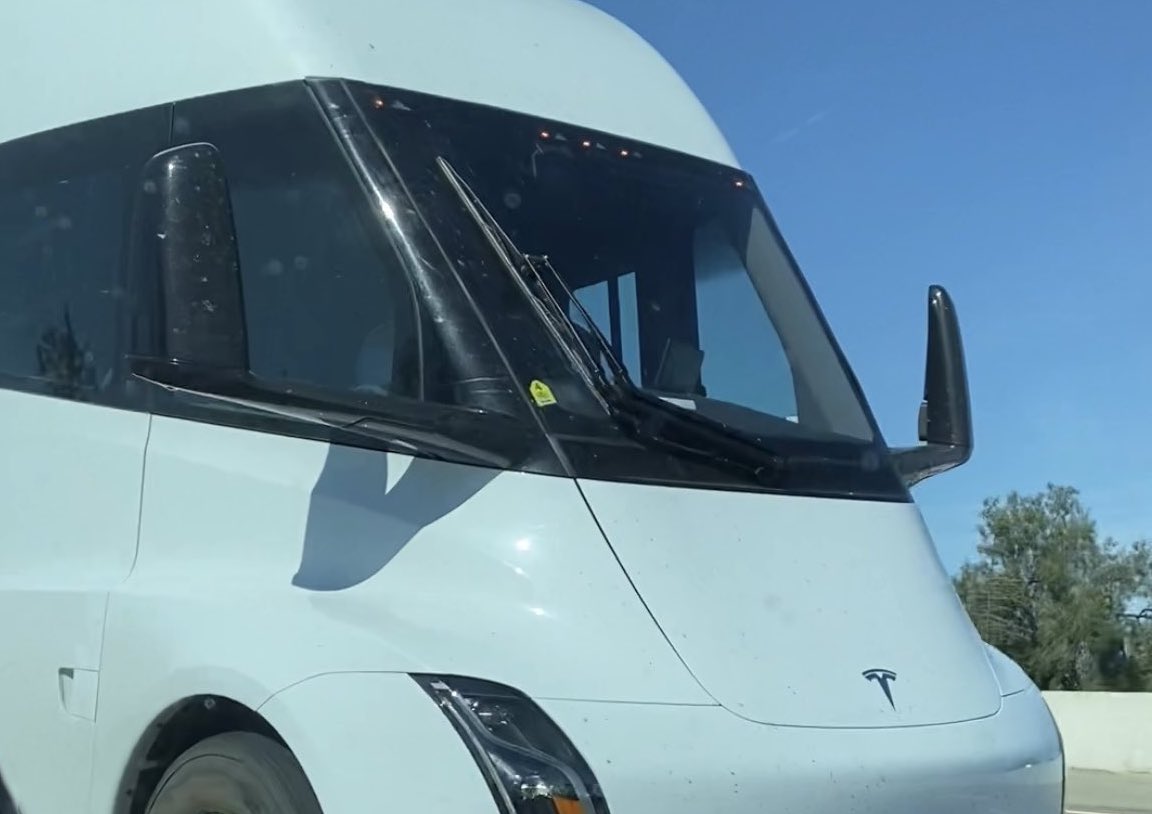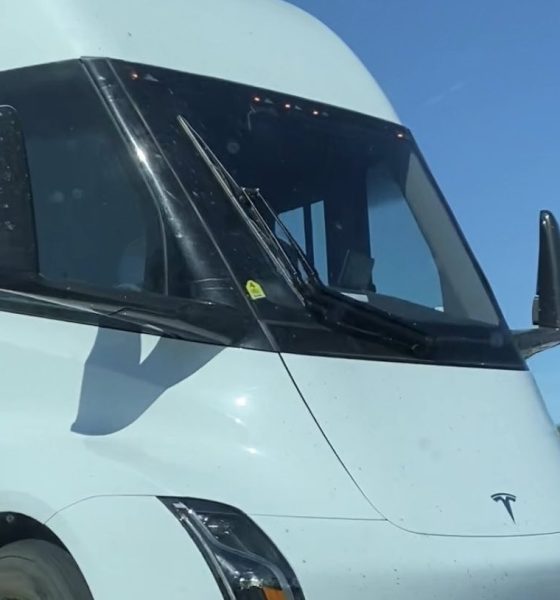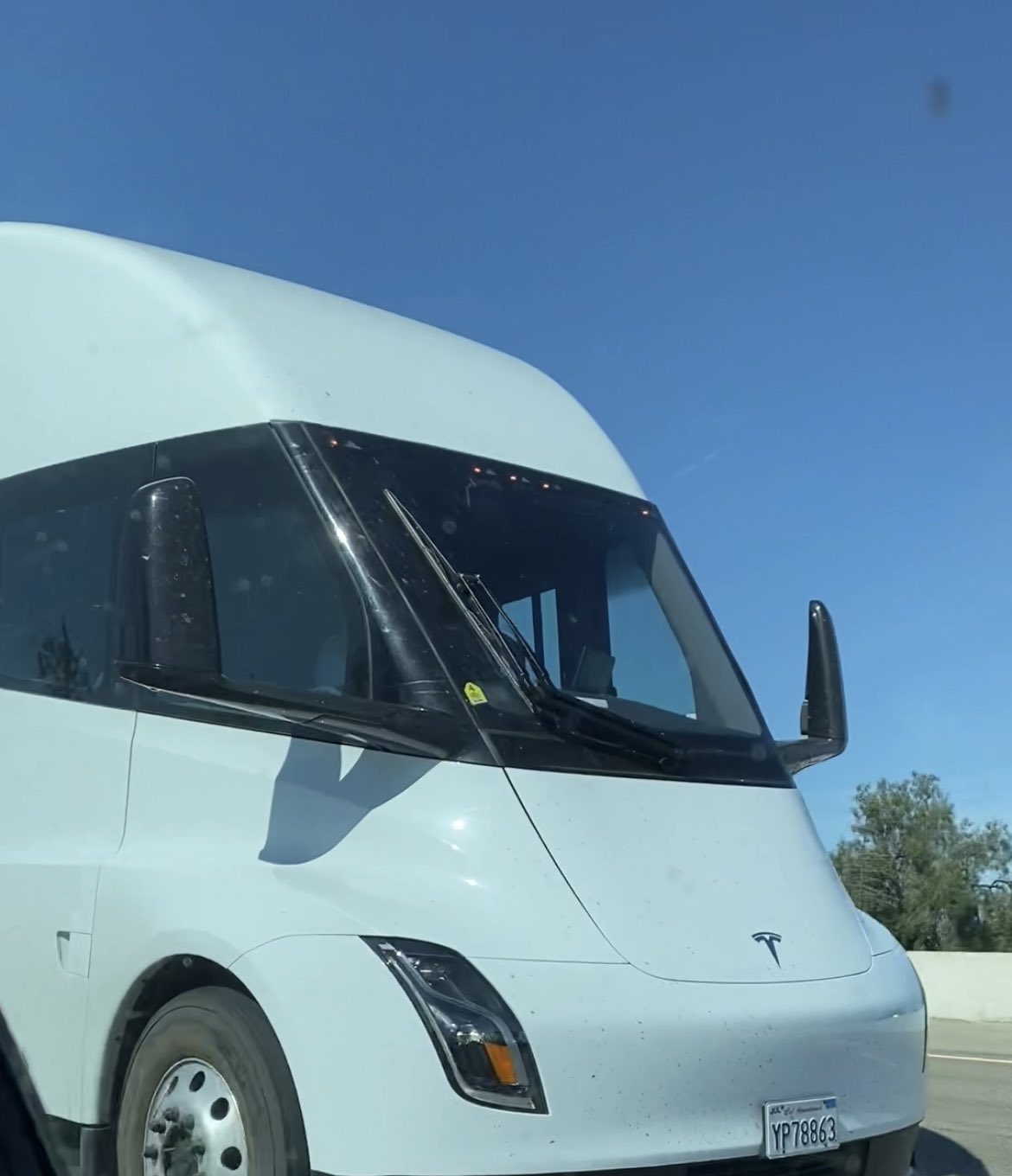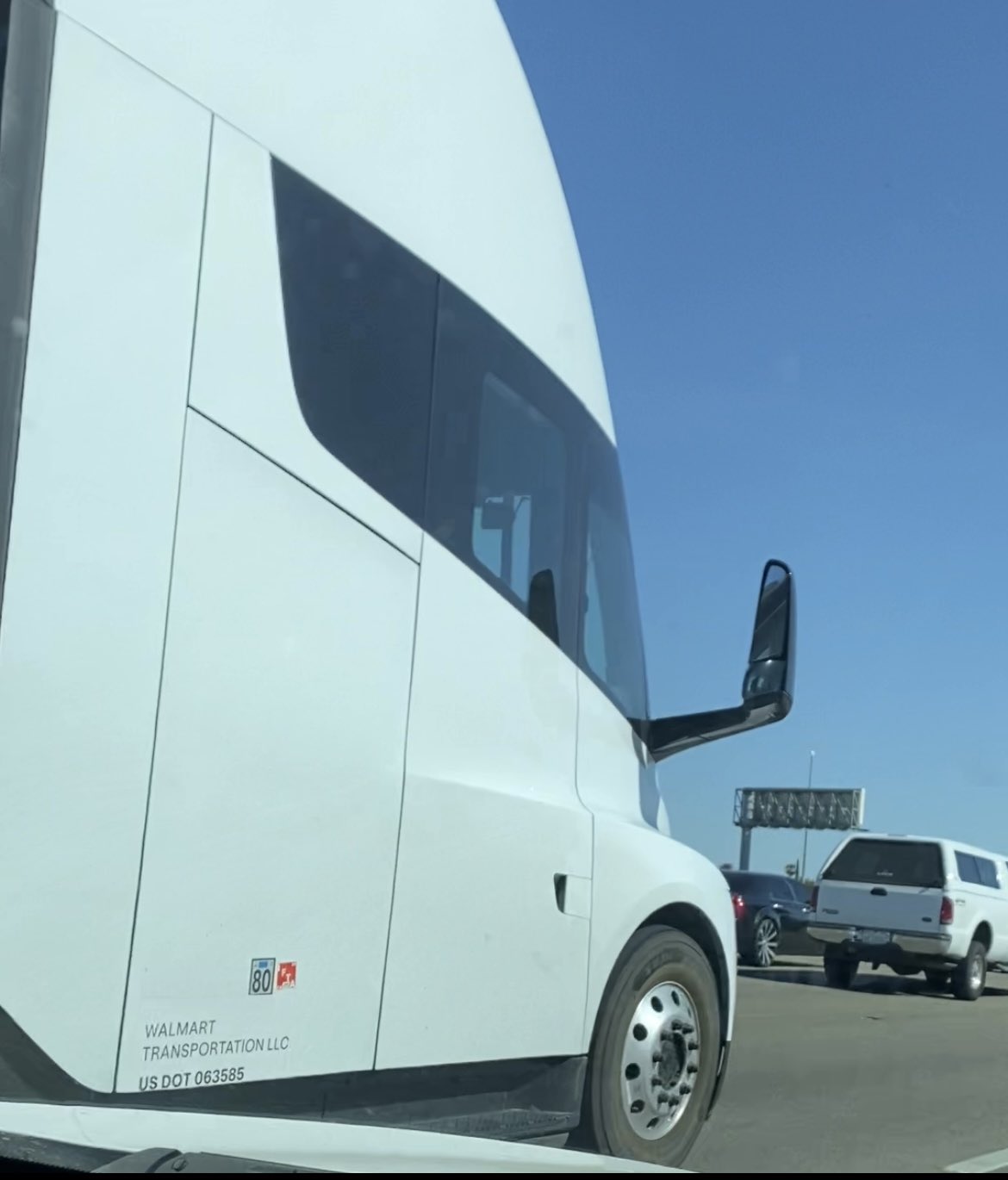

News
Walmart has taken delivery of a Tesla Semi, as spotted in California
Walmart has apparently taken delivery of a Tesla Semi, as one of the electric semi-trucks was seen driving on a highway in California over the weekend.
X user Accelerating Tech posted photos of a Walmart-branded Tesla Semi on Saturday, as spotted just a day earlier in Stockton, California. In addition to the Semi towing a Walmart trailer, the Tesla cab includes branding that says “Walmart Transportation LLC,” suggesting that the retailer has officially taken delivery of the vehicle as Tesla expands pilot programs beyond its initial deliveries to PepsiCo in 2022.
Teslarati has confirmed with Walmart that the company is using the Semi as part of a four-week pilot program for the electric Class 8 vehicle.
⚡️ WALMART Electric Tesla Semi truck spotted in Stockton, CA! Is this their first test truck from Tesla? From my brother on May 3. @SawyerMerritt @SERobinsonJr @teslaownersSV @TeslaClubSoCal @teslaownersSV @DillonLoomis22 @DMC_Ryan @ryanshawtech @DennisCW_ @BeardedTesla pic.twitter.com/YCLJ6E7E9q
— Accelerating.Tech (@AcceleratingTec) May 4, 2024

Credit: Accelerating.Tech | X

Credit: Accelerating.Tech | X
The news comes after Dan Priestley, Tesla Senior Manager of Semi-Truck Engineering, said last month posted a thank-you to new clients at Martin Brower, which also started piloting a Semi. Walmart has also had an ongoing order with Tesla for hundreds of Semi units, though this is the first time Tesla has been shown to be delivering those.
The Tesla Semi has been showing some promising results in early pilot programs at Pepsi, with the vehicle reaching over 1,000 miles in a single day in one test.
“Walmart is continuously testing and learning about different technologies and fuel types to help achieve Walmart’s 2040 goal of zero emissions,” said a Walmart spokesperson about the pilot in an email to Teslarati. “The Tesla Semi was part of a 4-week pilot to test real-world performance.”
You can also find more information about Walmart’s commitment to transitioning its Class 8 trucks to clean energy in a press release on the retailer’s website.
At the time of writing, Tesla has not responded to Teslarati’s requests for comment on the volume or status of the Walmart deliveries.
Tesla has generally been pretty quiet about the Semi program since it initially delivered around 20 units to Pepsi in 2022. In December 2023, Tesla Vice President of Vehicle Engineering Lars Moravy said that the total Semi fleet had almost reached 100 units.
During its Q1 earnings call last week, Tesla said that more Semi deliveries are expected for late 2025, while the company expects to begin external customer deliveries in 2026. In addition, Tesla broke ground on expansions to its Gigafactory Nevada in January, set to help increase Semi production as well as the production of the 4680 battery cell.
Updated 5/7/24: Added quote from a Walmart spokesperson. Third paragraph added after confirming Walmart’s pilot program for the Semi.
What are your thoughts? Let me know at zach@teslarati.com, find me on X at @zacharyvisconti, or send us tips at tips@teslarati.com.

News
Tesla FSD fleet is nearing 7 billion total miles, including 2.5 billion city miles
As can be seen on Tesla’s official FSD webpage, vehicles equipped with the system have now navigated over 6.99 billion miles.

Tesla’s Full Self-Driving (Supervised) fleet is closing in on almost 7 billion total miles driven, as per data posted by the company on its official FSD webpage.
These figures hint at the massive scale of data fueling Tesla’s rapid FSD improvements, which have been quite notable as of late.
FSD mileage milestones
As can be seen on Tesla’s official FSD webpage, vehicles equipped with the system have now navigated over 6.99 billion miles. Tesla owner and avid FSD tester Whole Mars Catalog also shared a screenshot indicating that from the nearly 7 billion miles traveled by the FSD fleet, more than 2.5 billion miles were driven inside cities.
City miles are particularly valuable for complex urban scenarios like unprotected turns, pedestrian interactions, and traffic lights. This is also the difference-maker for FSD, as only complex solutions, such as Waymo’s self-driving taxis, operate similarly on inner-city streets. And even then, incidents such as the San Francisco blackouts have proven challenging for sensor-rich vehicles like Waymos.
Tesla’s data edge
Tesla has a number of advantages in the autonomous vehicle sector, one of which is the size of its fleet and the number of vehicles training FSD on real-world roads. Tesla’s nearly 7 billion FSD miles then allow the company to roll out updates that make its vehicles behave like they are being driven by experienced drivers, even if they are operating on their own.
So notable are Tesla’s improvements to FSD that NVIDIA Director of Robotics Jim Fan, after experiencing FSD v14, noted that the system is the first AI that passes what he described as a “Physical Turing Test.”
“Despite knowing exactly how robot learning works, I still find it magical watching the steering wheel turn by itself. First it feels surreal, next it becomes routine. Then, like the smartphone, taking it away actively hurts. This is how humanity gets rewired and glued to god-like technologies,” Fan wrote in a post on X.
News
Tesla starts showing how FSD will change lives in Europe
Local officials tested the system on narrow country roads and were impressed by FSD’s smooth, human-like driving, with some calling the service a game-changer for everyday life in areas that are far from urban centers.

Tesla has launched Europe’s first public shuttle service using Full Self-Driving (Supervised) in the rural Eifelkreis Bitburg-Prüm region of Germany, demonstrating how the technology can restore independence and mobility for people who struggle with limited transport options.
Local officials tested the system on narrow country roads and were impressed by FSD’s smooth, human-like driving, with some calling the service a game-changer for everyday life in areas that are far from urban centers.
Officials see real impact on rural residents
Arzfeld Mayor Johannes Kuhl and District Administrator Andreas Kruppert personally tested the Tesla shuttle service. This allowed them to see just how well FSD navigated winding lanes and rural roads confidently. Kruppert said, “Autonomous driving sounds like science fiction to many, but we simply see here that it works totally well in rural regions too.” Kuhl, for his part, also noted that FSD “feels like a very experienced driver.”
The pilot complements the area’s “Citizen Bus” program, which provides on-demand rides for elderly residents who can no longer drive themselves. Tesla Europe shared a video of a demonstration of the service, highlighting how FSD gives people their freedom back, even in places where public transport is not as prevalent.
What the Ministry for Economic Affairs and Transport says
Rhineland-Palatinate’s Minister Daniela Schmitt supported the project, praising the collaboration that made this “first of its kind in Europe” possible. As per the ministry, the rural rollout for the service shows FSD’s potential beyond major cities, and it delivers tangible benefits like grocery runs, doctor visits, and social connections for isolated residents.
“Reliable and flexible mobility is especially vital in rural areas. With the launch of a shuttle service using self-driving vehicles (FSD supervised) by Tesla in the Eifelkreis Bitburg-Prüm, an innovative pilot project is now getting underway that complements local community bus services. It is the first project of its kind in Europe.
“The result is a real gain for rural mobility: greater accessibility, more flexibility and tangible benefits for everyday life. A strong signal for innovation, cooperation and future-oriented mobility beyond urban centers,” the ministry wrote in a LinkedIn post.
News
Tesla China quietly posts Robotaxi-related job listing
Tesla China is currently seeking a Low Voltage Electrical Engineer to work on circuit board design for the company’s autonomous vehicles.

Tesla has posted a new job listing in Shanghai explicitly tied to its Robotaxi program, fueling speculation that the company is preparing to launch its dedicated autonomous ride-hailing service in China.
As noted in the listing, Tesla China is currently seeking a Low Voltage Electrical Engineer to work on circuit board design for the company’s autonomous vehicles.
Robotaxi-specific role
The listing, which was shared on social media platform X by industry watcher @tslaming, suggested that Tesla China is looking to fill the role urgently. The job listing itself specifically mentions that the person hired for the role will be working on the Low Voltage Hardware team, which would design the circuit boards that would serve as the nervous system of the Robotaxi.
Key tasks for the role, as indicated in the job listing, include collaboration with PCB layout, firmware, mechanical, program management, and validation teams, among other responsibilities. The role is based in Shanghai.
China Robotaxi launch
China represents a massive potential market for robotaxis, with its dense urban centers and supportive policies in select cities. Tesla has limited permission to roll out FSD in the country, though despite this, its vehicles have been hailed as among the best in the market when it comes to autonomous features. So far, at least, it appears that China supports Tesla’s FSD and Robotaxi rollout.
This was hinted at in November, when Tesla brought the Cybercab to the 8th China International Import Expo (CIIE) in Shanghai, marking the first time that the autonomous two-seater was brought to the Asia-Pacific region. The vehicle, despite not having a release date in China, received a significant amount of interest among the event’s attendees.








